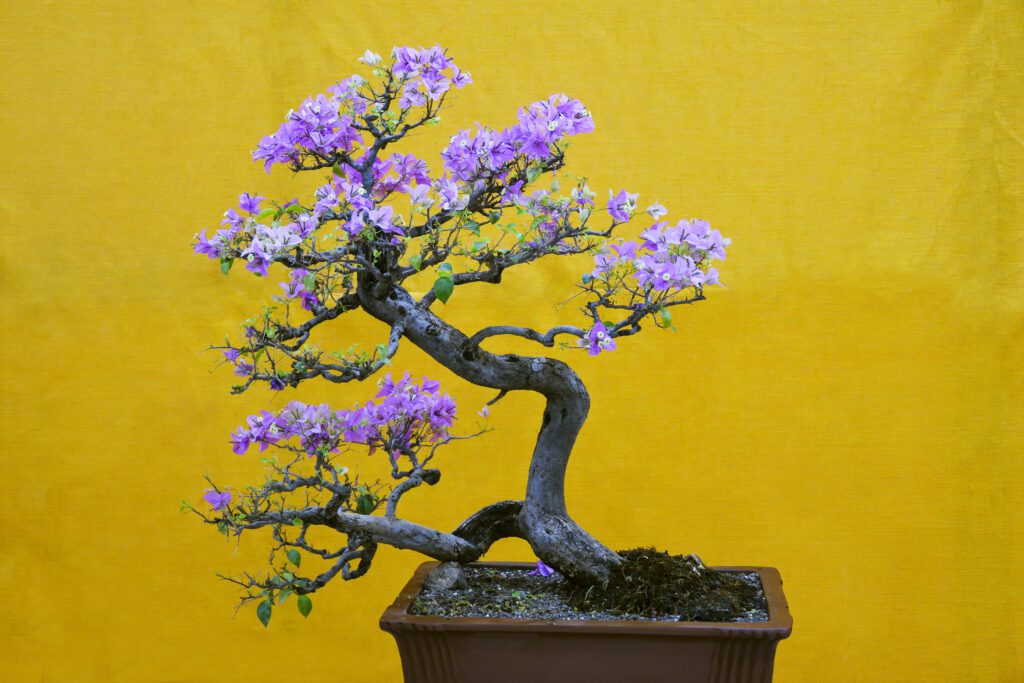It’s no wonder why bonsai enthusiasts are drawn to Bougainvillea spectabilis. It is a hard-stemmed plant that meets the requirements of bonsai.
Bougainvillea is fast-growing, have abundant blooms, loves heat, tolerates cool, is easy to care for, and has alternate leaves. They are a perfect tropical flowering bonsai tree that can be grown indoors and out.
Originally discovered in Brazil, the genus Bougainvillea consists of approximately 15 species. Every variety of Bougainvillea produces thorny storms and long-lasting flowers in various colors.
This deciduous shrub-like plant naturally climbs (which requires constant pruning during the growing season), features dark green elliptic leaves, and is usually pruned heavily to achieve the proper bonsai aesthetic.
Common Bonsai Styles That Are Achieved With Bougainvillea Are:
- Informal Upright
- Semi-Cascade
- Cascade
Because Bougainvillea is a popular tropical plant in general, many nurseries and garden centers carry them.
Bougainvillea Care Tips
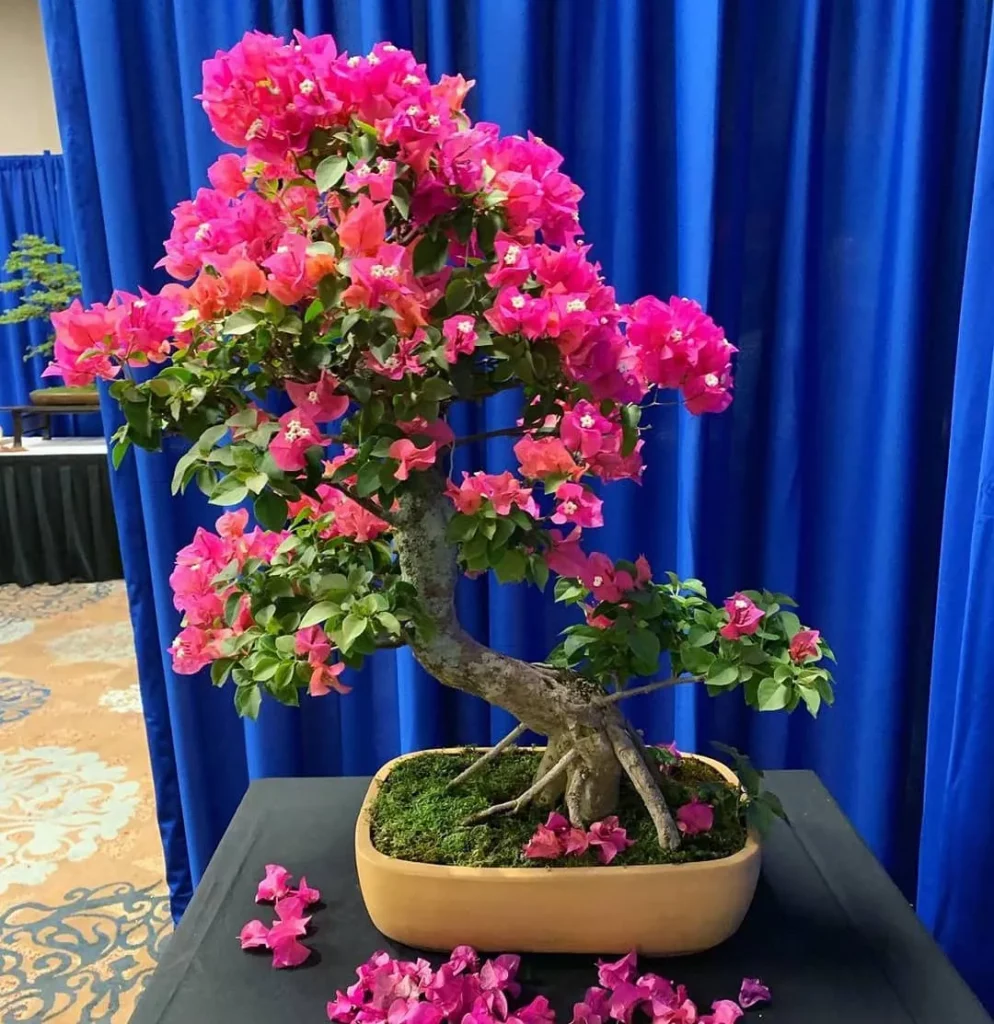
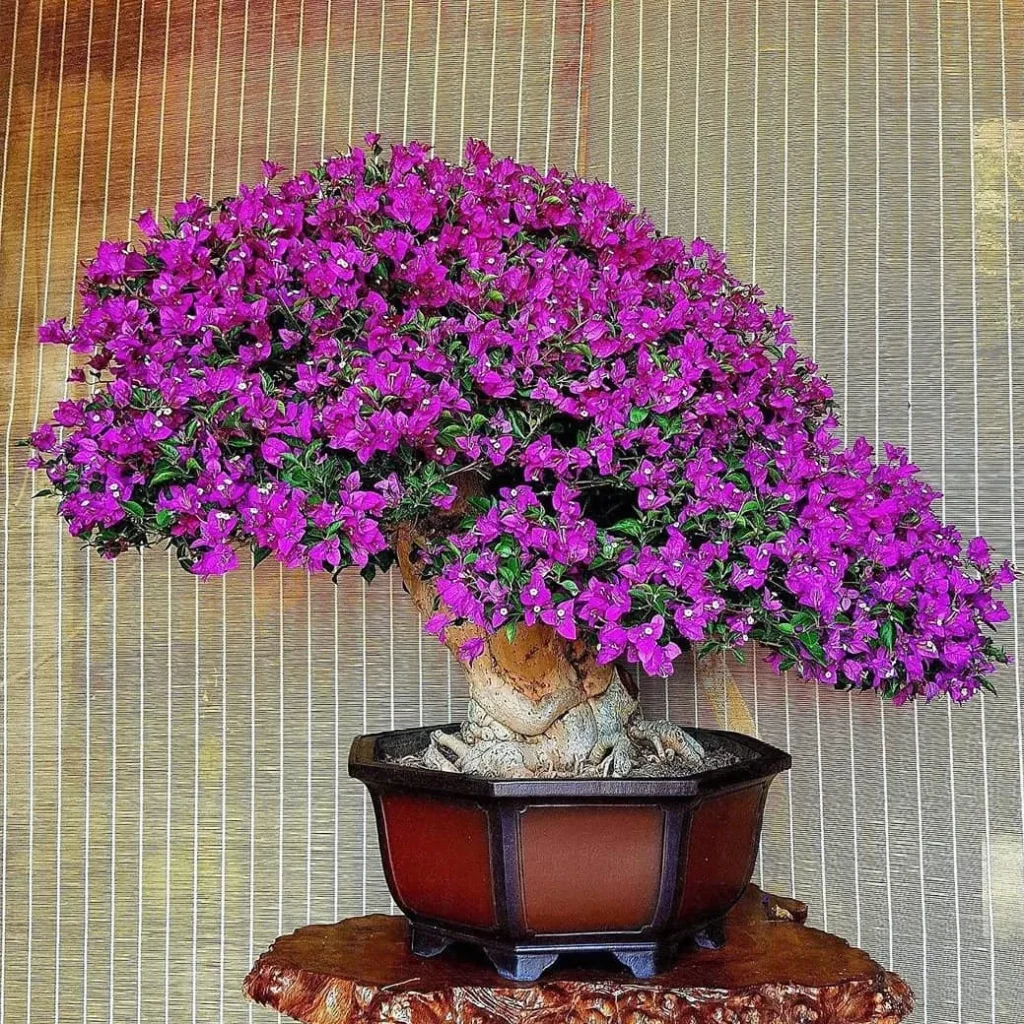
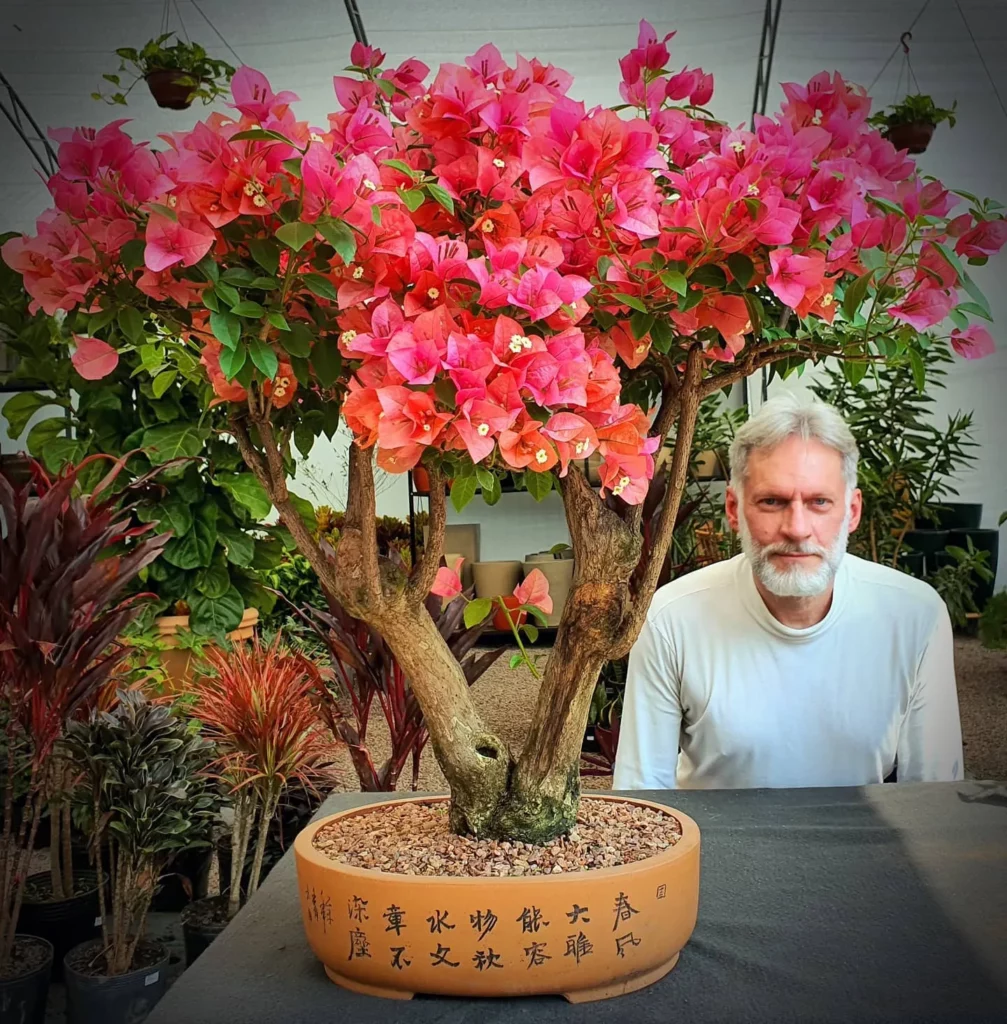
Bonsai bougainvillea care is very basic: lots of sun and not too much water. Between waterings, allow the top of the soil to become dry to the touch. Especially during the first stages of bonsai training, you could have problems if you water it as much as many other bonsai.
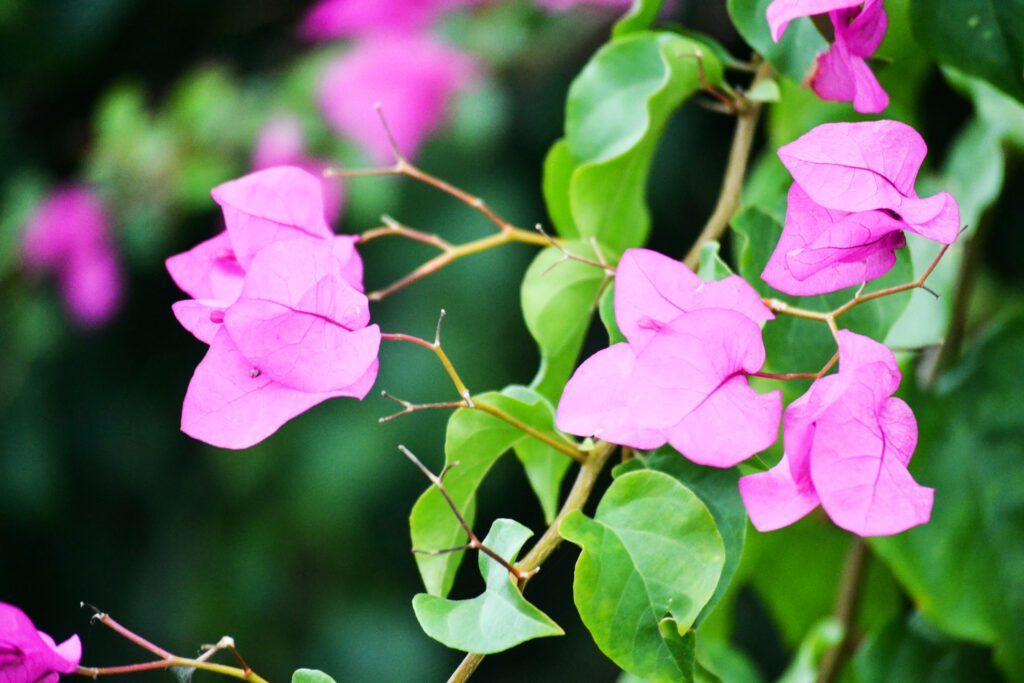
- If your style deserves a shallow container, this is a plant that does well in modest amounts of soil.
- Root pruning every two-three years should be sufficient. Trim roots during the summer. (In the tropics, you may prune roots any time of year.)
- Full sun will keep the growth compact.
Frost Intolerant: Bougainvillea can handle mild weather (no deep winter) if grown outside. Make sure not to have your Bougainvillea outside if there’s a frost imminent.
No products found.
There are many variations – shrubs, vines, and even small trees. They each have different growth patterns. Although most are armed with spines, some are less hazardous than others. Thorns can be an inch long or barely noticeable. When pruning bonsai Bougainvillea, be cautious!
Training Bougainvillea For Bonsai
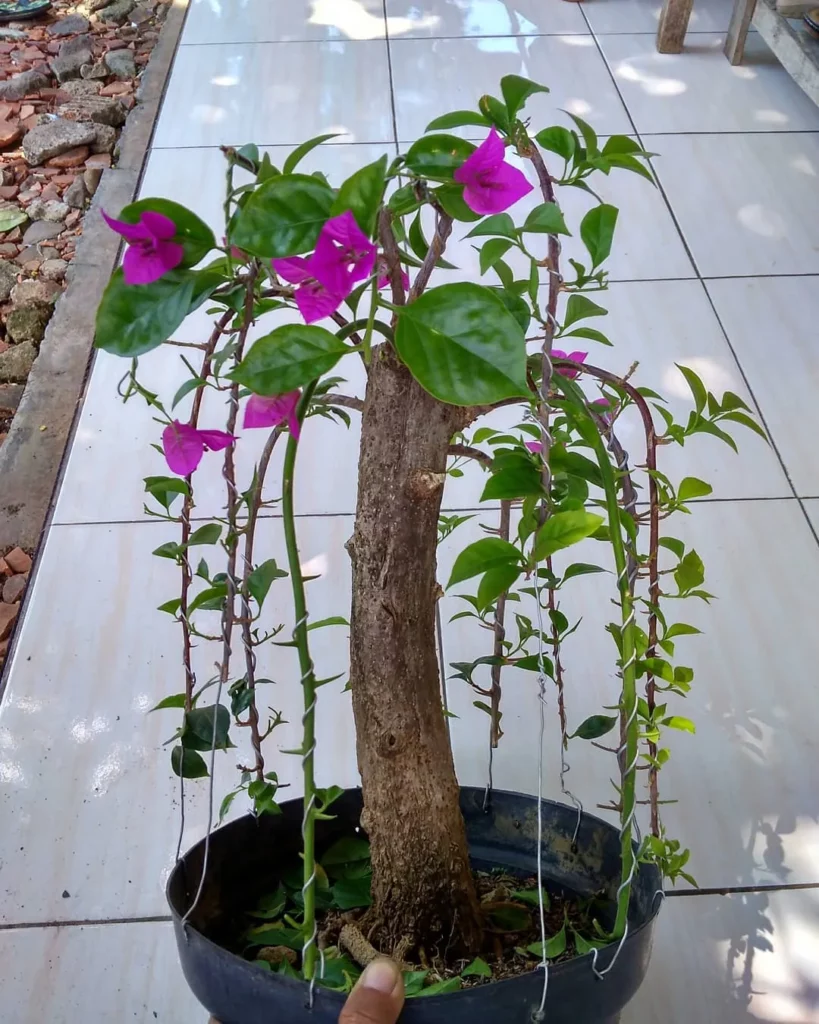
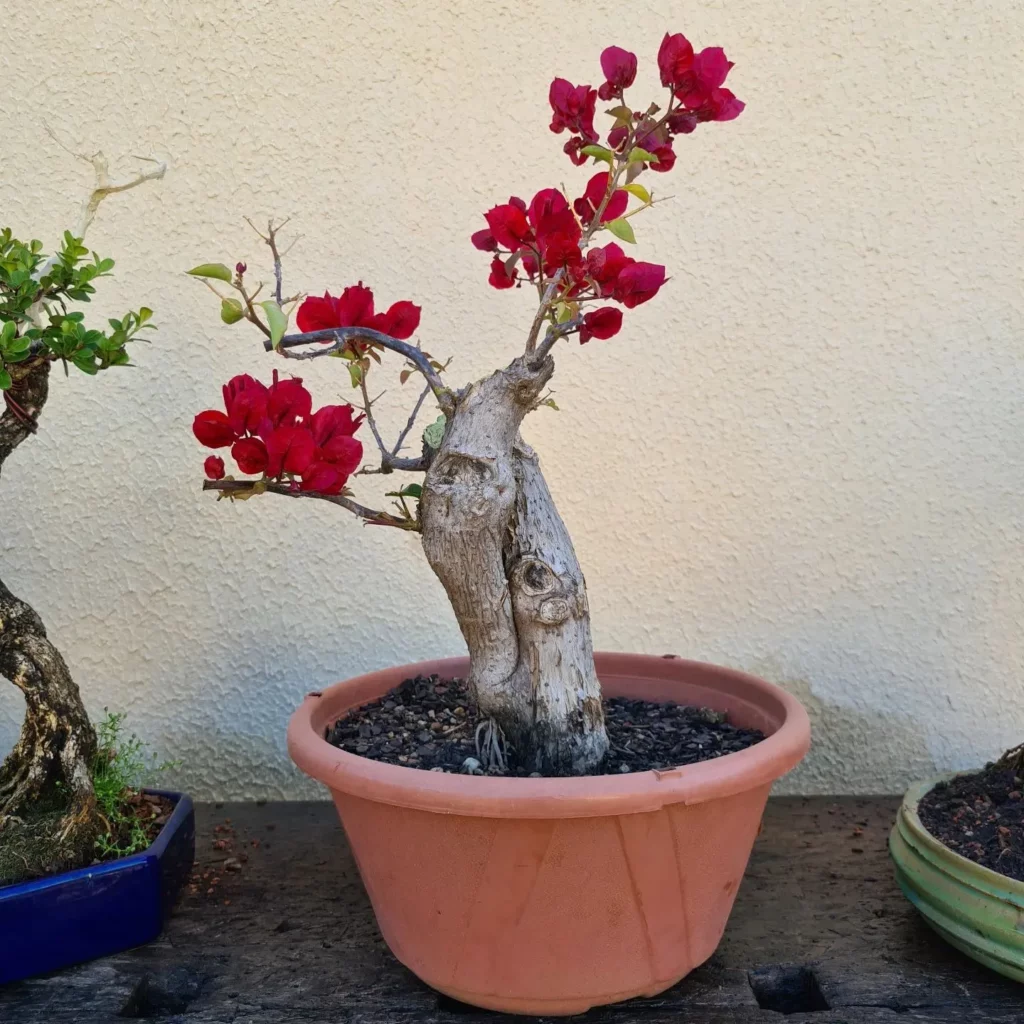
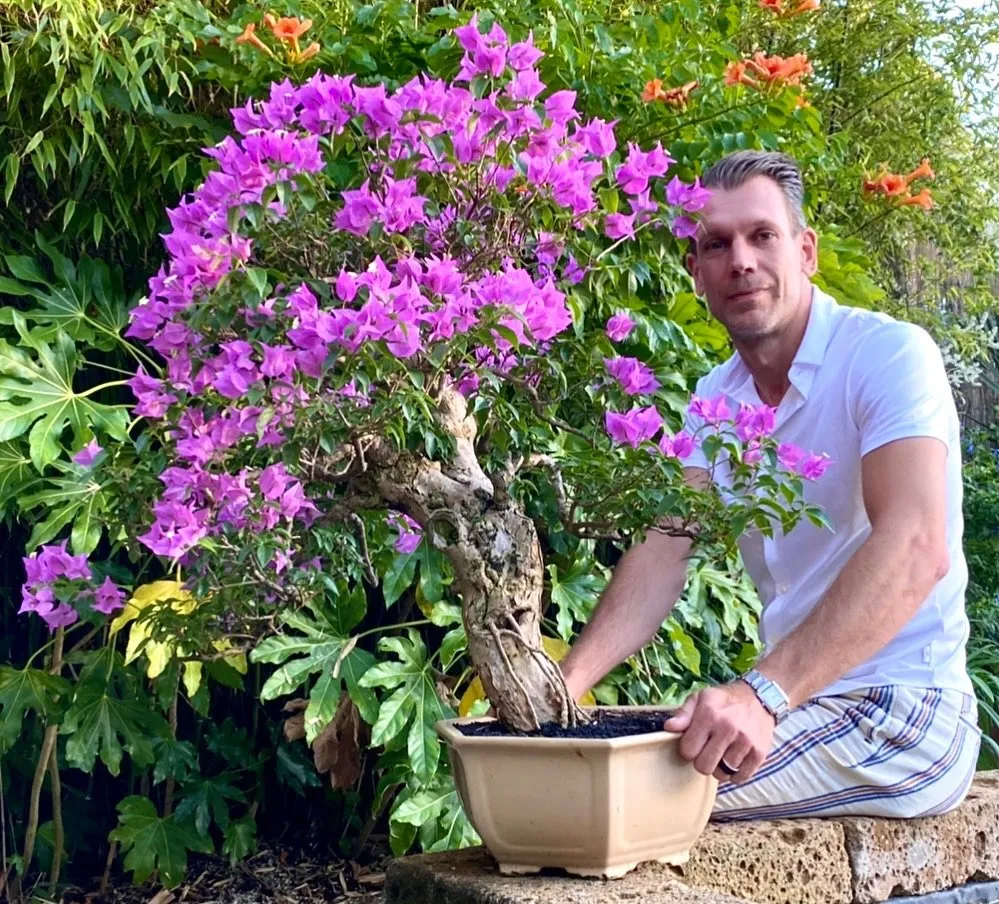
To create a bonsai, removing many of the original thick branches is not unusual and restructuring the design from new growth. Let it sprout new branches, eliminating any new buds not necessary to the desired shape.
The new growth is fast growing, easily shaped with wire, and becomes woody very quickly. Watch that the bonsai wire does not cut in. Keep in mind, that very young branches snap off easily at the point where they come off the trunk. Pay special attention to this when wiring.
Pro Tip: Bougainvillea glabra ‘pink pixie’ has a harder wood and is much less susceptible to rot than many varieties. The new branches also seem to harden faster. This variety is a good one to start with a skeleton and build upon it. Old specimen trunks of this variety can often be carved.
The nature of the ‘Pixie’ branches is to grow straight up.
New branches should be wired as soon as possible to set them in the right direction. Creating a bonsai with this variety will take some patience. The results are worth it.
Pro Tip: As with any species, not every plant of that species makes a good bonsai.
Be cautious of very straight trunks with no nebari and too many heavy branches when purchasing bonsai or pre-bonsai. With a little patience and discretion, you can find a ‘bougie’ with good bonsai potential.
When grown in the landscape of warm climates, full sun, and fast draining, rocky soil suits this plant. Especially during the first stages of bonsai training, full sun keeps the growth compact. If you’ve ever killed one of these tropical bonsai, too much water (and poor soil) was likely the problem.
Excess water can cause yellowing, leaf drop and root rot. Improper soil (not fast draining) is often the source of difficulties.
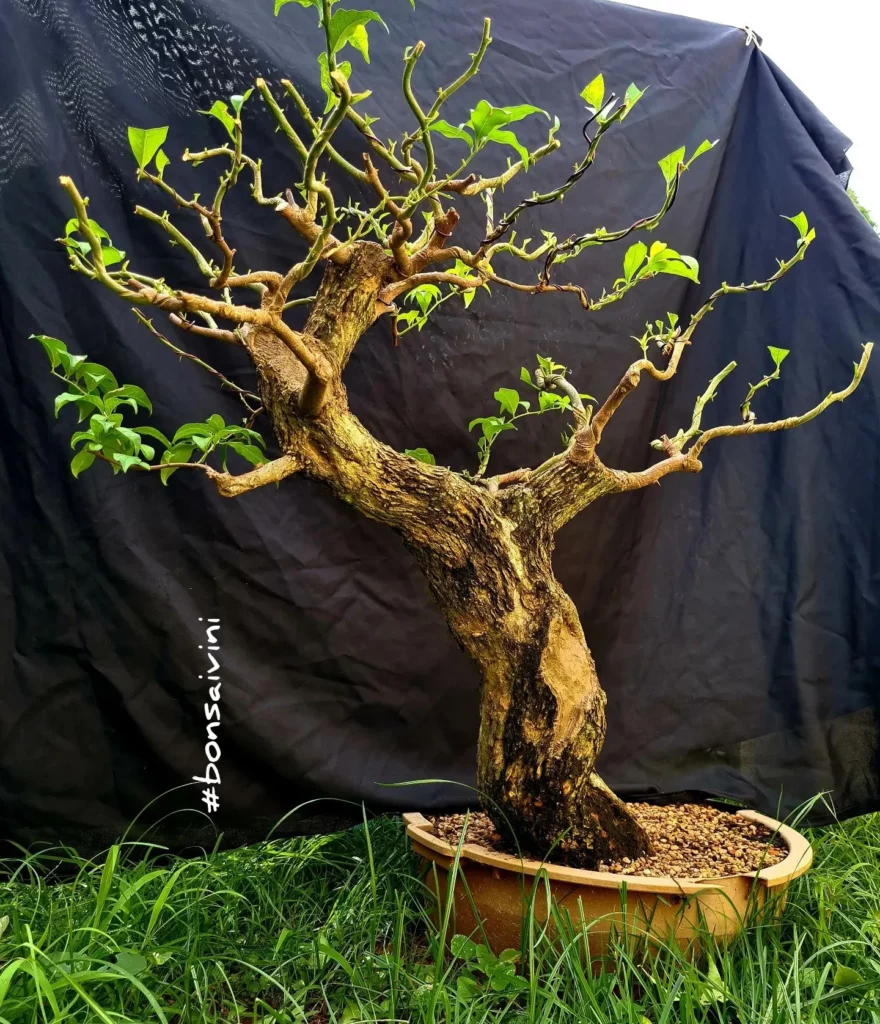
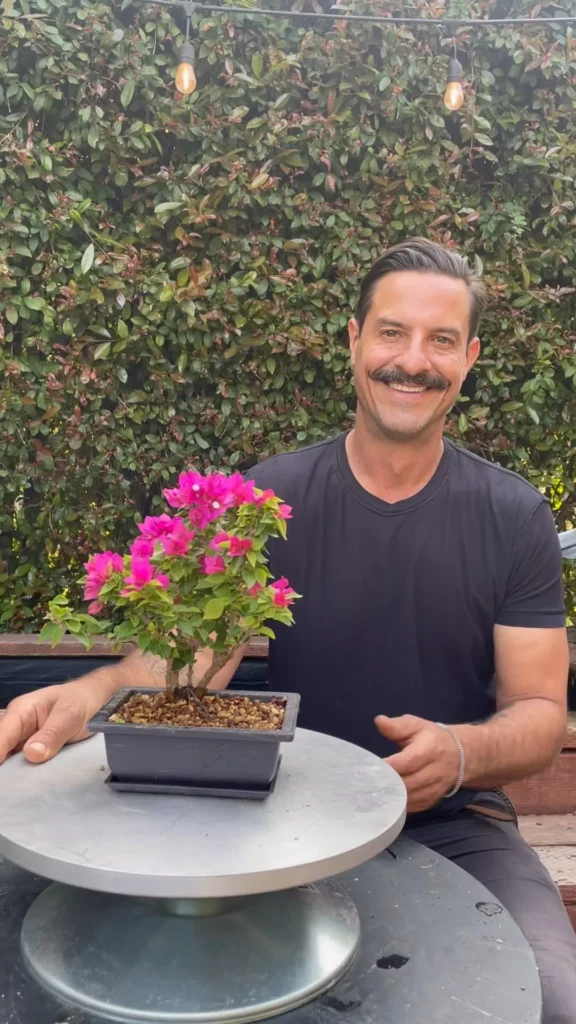
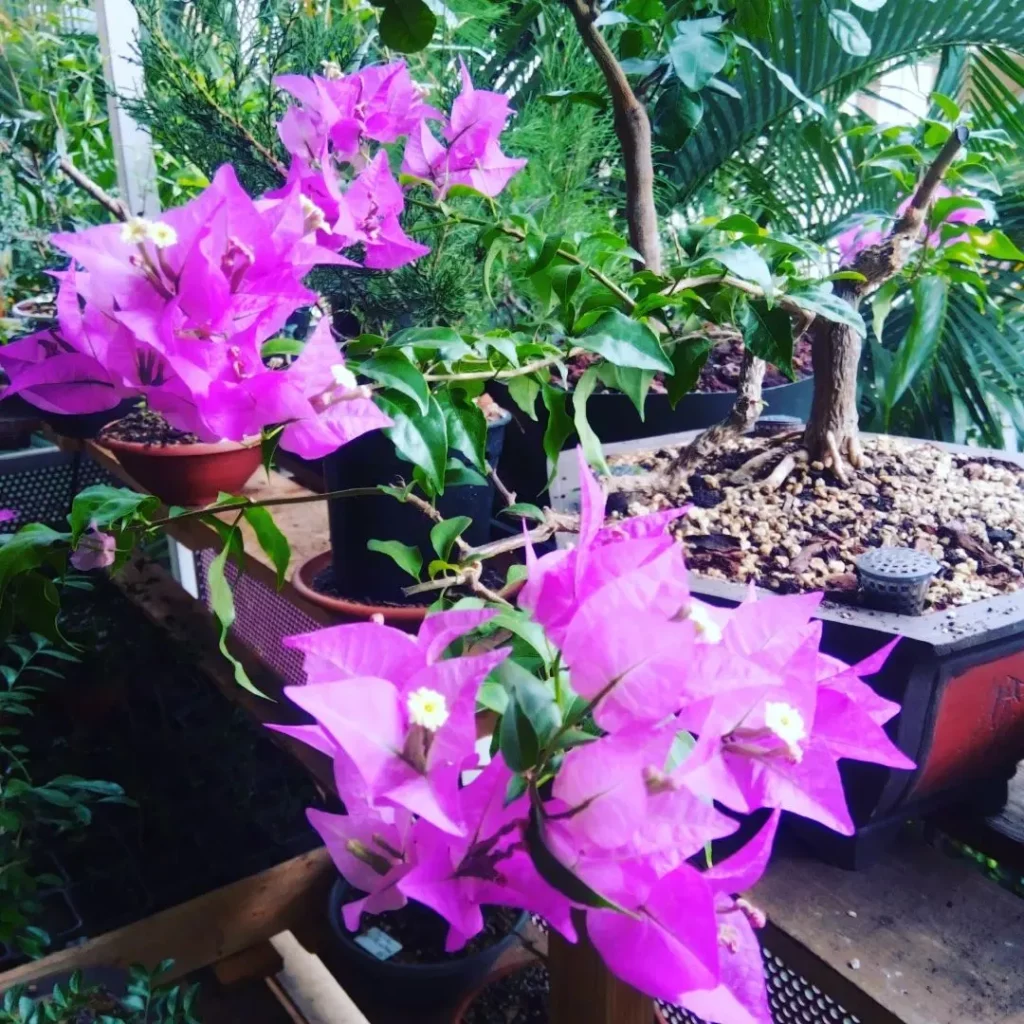
Bougainvillea Fertilizer
The best practice is to feed your Bougainvillea every month during the growing season (Late Spring – Late Summer).
Balanced fertilizers are best (5-5-5) that have equal amounts of nitrogen, phosphorus, and potassium. Do not feed in the off-season (usually, dormancy starts late Fall and lasts until Spring).
Once your tree is potted, in full bloom, and ready for display, remove some of the remaining green leaves. This will make the color appear even more grand and bountiful.
Most growers agree to avoid high nitrogen content (the first number in the list of three). Even numbers or a higher middle number are considered best. Learn more about fertilizer here.
No products found.
“Bougie” Display Tip
Bougainvillea is known for its lasting blooms. Their flowers come in various colors, including pink, red, purple, white, and yellow. So what’s the trick to get a beautiful, long-lasting color from your Bouganvillea?
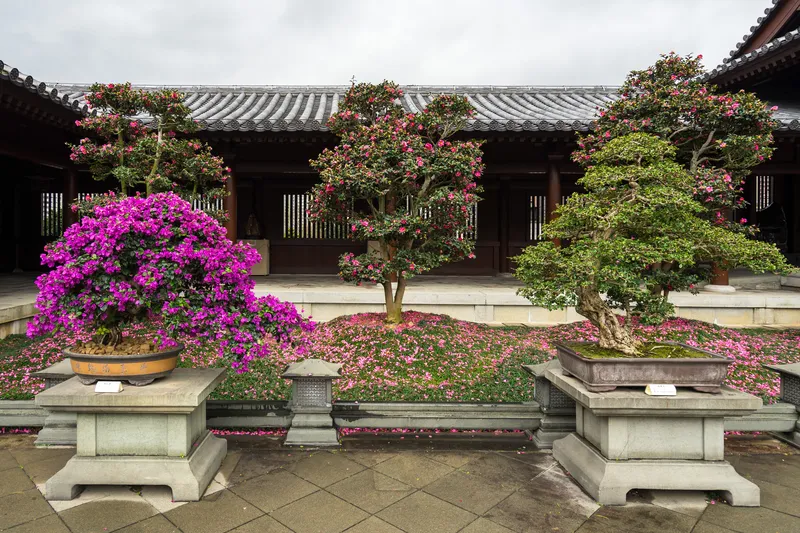
Remove Some Leaves
Bonsai Bougainvillea prefers ‘tight feet,’ almost rootbound. After blooming is a good time to hard prune and/or restyle. Also, defoliate the leaves at least once a year in the spring or summer to encourage smaller leaves and additional branching.
Can I Grow It Indoors?
Absolutely! Bougainvillea does well in high-light placements inside. Monitor the soil’s moisture so it never dries out completely (but DO NO overwater).
Proper Substrate
Soil should be coarse and fast draining but still contain some organic matter. Make sure to have an “airy” feel to the composition. Learn more about bonsai soil.
Bonsai Bougainvillea Pests
Indoors and out aphids on new growth may be a minor problem. When grown outdoors, bonsai bougainvillea care is almost pest free — other than one caterpillar that can be annoying.
The “cabbage looper” is small, green, active at night, and a voracious feeder.
The cabbage looper rolls itself in a leaf and/or chews them. To eliminate this critter, use an insecticidal soap or a spray with pyrethrin.
Bougainvillea Propagation
One of the most beautiful bonsai Bougainvillea I ever saw was about ten inches at the base and only 12-14 inches tall. I was shocked to learn it was a sawed-off cutting from an old plant being thrown out by a neighbor!
See severe, but not dangerous, styling examples at the bottom of this page.
Pruning And Styles
Because this plant has alternate leaves, it is a good subject for directional pruning.
Bonsai bougainvillea care includes frequent trimming.
You may trim foliage any time of year. Be cautious not to trim off bracts when foliage begins to turn color. (Watch for a rosy tinge to the leaves.)
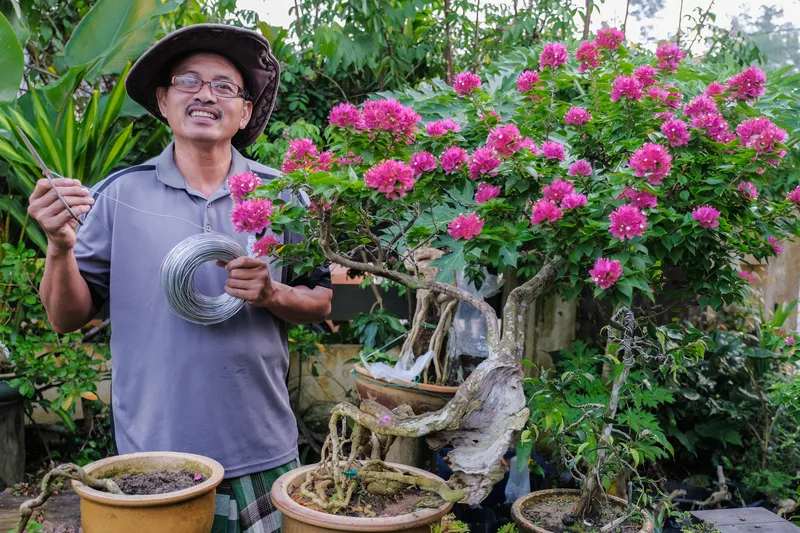
Bougainvillea bonsai – fast growing, abundant blooms, loves heat, tolerates cool, easy to care for, alternate leaves! What more could you ask from a tropical flowering bonsai tree?
There are many variations – shrubs, vines and even small trees. They each have different growth patterns. Although most are armed with spines, some are less hazardous than others. Thorns can be an inch long or barely noticeable. When pruning bonsai Bougainvillea be cautious!
Old Bougainvillea Bonsai
Old trees sometimes have hollow trunks, which add to the tree’s character. These cavities must be maintained. The soft wood of most Bougainvillea deteriorates quickly.
Clean out any rotted, soft or pulpy areas. Then protect the exposed dead wood (without bark) with wood hardener.
What Are Bougainvillea Bracts?
“Bract – a leaf, often modified or reduced, which subtends a flower or inflorescence in its axil.” — “Flowering Trees of the World” –Editor: V. H. Heywood
Yes, a bract is a leaf. Bougainvillea bonsai is a good example of how conspicuously colorful these “leaves” can be!
In reality, Bougainvillea bonsai have no flower petals. Look closely at what you may have thought the flower; you will see where the colored bracts surround the white tubular flowers. (Poinsettia and dogwood are two other examples of plants with bracts.)
When styling a bonsai Bougainvillea, remember the exciting colors it will eventually provide.
Form pads, canopies, or long sweeping limbs to create special areas of fullness to allow this display.
All bonsai styles and sizes, including shohin are possible with this exotic flowering bonsai subject.
Fast growing, abundant blooms, loves heat, tolerates cool, easy bonsai bougainvillea care, alternate leaves – what more could you ask for in a tropical bonsai? This scraggly bougainvillea plant was found in a South Florida landscape nursery. It was used in a bonsai demonstration in Ft. Myers, Florida.
Removing many or all old branches in the beginning is not unusual. Don’t be afraid to cut.
To a novice, the initial results may seem a bit scary.
Flexible young branches will allow many new possibilities during the initial bonsai training process.
This is a “no fear” bonsai subject. Creating a good skeleton is what it’s all about. In the long term, this stump will be a magnificent bonsai tree.
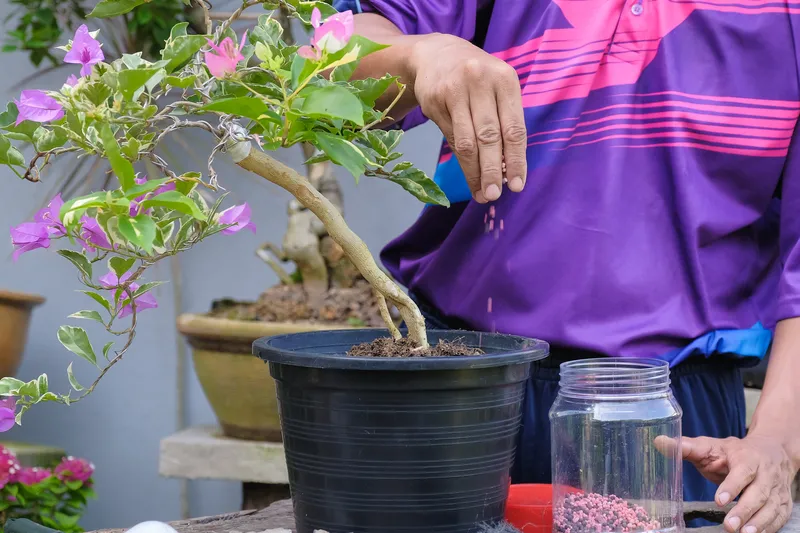
Gardener taking care of the bougainvillea bonsai in the garden
After this check out our other articles on:
Bougainvillea Bonsai Questions
Can You Bonsai A Bougainvillea?
The bougainvillea is a great candidate to transform into a beautiful bonsai specimen. It has long-lasting flowers, is hardy, and gives a lot of opportunity to new growers to prune and form throughout the growing season.
How Long Does It Take To Make A Bougainvillea Bonsai?
Usually, it takes two growing seasons to see your bougainvillea bonsai come into shape. The first year is dedicated to general shaping, and the second year can fine-tune the shape. After the second year, bougainvillea can be considered a full-fledged bonsai.
How Do You Make Bonsai Bougainvillea?
Pruning and shaping the flexible branches of bougainvillea is the easiest way to make a bonsai from it. Bougainvillea gives bonsai enthusiasts a lot of opportunities to create a bonsai because of its high growth rate.
Does Bougainvillea Like Sun Or Shade?
Bougainvillea is a tropical plant that loves the sun. Do not be afraid to place it in full-sun locations so long as you properly water it (do not let it dry out).
Where To Go From Here
See other flowering bonsai trees, and look at this frequent bloomer – Dwarf Powder Puff .

